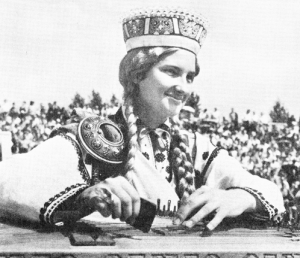JG 89
JG 89
For the past 4 years, Jaunā Gaita has devoted one issue annually to the literature and art of Soviet Latvia. The current selections are not in any way intended to represent the best in artistic creativity during 1971; however, viewed as a unit, they hold a number of surprises for the western reader. Apart from the high literary quality, the writings are completely free from "Soviet provincialism" or political ideology; not a single author pays even lip-service to social realism. This liberation has been true of the best poetry for some time, but has been harder to find in prose. The short stories reprinted here probe the inner man, analyzing his most personal thoughts and emotions; two of them are written in stream-of-consciousness technique. That may be nothing new in Western Europe or America, but coming from one of the Soviet republics, such thematic and stylistic developments hold great promise for the future. Another noteworthy characteristic is the subtle use of external objects as symbols for the protagonists' experiences: a snow-covered statue (Egils Lukjanskis' "Woman of Bronze "), a female skeleton and a string of marriage beads at an archeological dig (Alberts Bels' "Green Sails of Illusion") or a heap of glazed tiles that a bricklayer meticulously files and fits together (Aivars Kalve's „Tiled Stove"). The protagonists in all the stories are essentially lonely men, mentally separated even from those nearest to them. Lukjanskis probes the winter despair that attends the death of love and the final break of communication between husband and wife. Bels' young archeologist, giving way to the intoxication of nature and visions of the ancient past, awakens to find that the erotic relationships of the present end on a bleak morning. Kalve at first seems to be laughing about the petty, isolated little hopes of little people, but ends by exposing their pathos. Even in Uldis Zemzaris' hilarious satire, „Interview with Artist B.," there is a subtly ironic undertone. As a windy critic spouts endless phrases about the metaphysics of art, she can never comprehend the embarrassed artist's laconic statement--- "well, I just paint".
Ojārs Vācietis and Andris Vējāns have long been recognized as major talents and innovators in Soviet Latvian poetry. The selections here include Vācietis' "Piano Concerto", an elaborate extension of Baudelaire's theory of "correspondences" in nature into the realms of art and intellect. Another fascinating poem is Vējāns' „Life of Andryvs Jūrdžs" written in the Latgallian dialect; it vividly brings to life the unique atmosphere of that ancient region. Dagnija Dreika has won high praise for the resonance of language and unique, paradoxical use of images exemplified in her first poetry collection, Brown Stars. However, the greatest enthusiasm among Latvian poets in 1971 was aroused by the publication of the collections by Monta Kroma and Ilze Binde. This issue of JG reprints Kroma's review of Binde's Mad Crickets. Kroma praises the striking, unexpected images and unusual structure of Binde's poetry. Reprinted also is Vācietis' discussion of Kroma's beautifully controlled use of vers libre. Vācietis emphasizes that "free verse" is no more free of artistic constraints than the sonnet; often abused by incompetents, it can be effectively used only by the most skillful artists of words.
Laimonis Mieriņš (Leeds, England) states in his essay "Notes on Soviet Latvian Art During 1971" that current Latvian art ranges from social realism to moderate modernity; however, there is much less experimentation and innovation than in the neighboring Baltic countries, Estonia and Lithuania. Numerous reproductions that accompany his article tend to illustrate the essential conservatism of Soviet Latvian artists. However, Tālivaldis Kiķauka (Canada), in rewiewing folios of paintings by Leo Kokle and Rūdolfs Pinnis, finds that Pinnis' simplified compositions and striking use of color might make his work worthy of being exhibited in the West.
It may be a little ironic that the only "politically concerned" essays in this issue are by émigré Latvian authors. Pāvils Klāns (Denmark) writes about the dangers of increasing industrialization and russification in Latvia, and Māris Bite (England) tries to sum up young people's opinions of the Latvian press. Bite concludes that Soviet Latvian and émigré Latvian publications are almost equally guilty of trying to manipulate public opinion; in fact, the only publication that has consistently attempted to be objective and impartial is Jaunā Gaita.
In the current installment of his monograph The Commander from Zemgale, Uldis Ģērmanis (Stockholm) chronicles the October Revolution in Russia and the role of the red Latvian riflemen in securing the Baltic regions for the Bolsheviks.
The cover is by L. Zikmane.
I. Š.-L.

Foto: L. Balodis